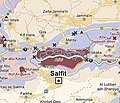West Bank
City settlements in the West Bank
Four settlements have been given city status. Their combined population is over 210,000, representing around half of the West Bank settler population outside of East Jerusalem.
| Name | Hebrew | Image map | Population (2022) [7] | Est. [7] | Council |
|---|---|---|---|---|---|
| Ariel | אריאל |  | 20,520 | 1978 | Shomron |
| Beitar Illit | ביתר עילית |  | 64,016 | 1985 | Gush Etzion |
| Ma'ale Adumim | מעלה אדומים |  | 38,046 | 1975 | Gush Etzion |
| Modi'in Illit | מודיעין עילית |  | 83,356 | 1996 | Mateh Binyamin |
Other settlements in the West Bank, excluding East Jerusalem
Several former Israeli outposts have been retroactively "legalized" under Israeli law as "neighborhoods" of formerly existing Israeli settlements:
- Givat Harsina, also called Ramat Mamre, legalized as "neighborhood" of Kiryat Arba
- Kfar Eldad, considered a "neighborhood" of Nokdim
- Kerem Reim, retroactively legalized as a "neighborhood" of Talmon
- Leshem, retroactively legalized as a "neighborhood" of Alei Zahav
- Neria, retroactively legalized as a "neighborhood" of Talmon
- Nofei Nehemia, retroactively legalized as a "neighborhood" of Rehelim
- Sdeh Bar Farm, retroactively legalized as a "neighborhood" of Nokdim
- Shvut Rachel, retroactively legalized as a "neighborhood" of Shilo
- Tal Menashe, retroactively legalized as a "neighborhood" of Hinanit
- Yair Farm, retroactively legalized as a "neighborhood" of Yakir
East Jerusalem
Following the capture and occupation of the West Bank, including East Jerusalem in 1967, the Israeli government effectively annexed the formerly Jordanian occupied territory and extended the Jerusalem municipality borders by adding 70,500 dunams of land with the aim of establishing Jewish settlements and cementing the status of a united city under Israeli control. The Jerusalem Master Plan 1968 called for increasing the Israeli population of Arab East Jerusalem, encircling the city with Israeli settlements and excluding large Palestinian neighborhoods from the expanded municipality. [8] Jerusalem was effectively annexed by Israel in 1980, an act that was internationally condemned and ruled "null and void" by the United Nations Security Council in United Nations Security Council Resolution 478. The international community continues to regard East Jerusalem as occupied territory and Israel's settlements there illegal under international law. [1]
| Name | Hebrew | Population (2019) [9] [10] | Est. |
|---|---|---|---|
| East Talpiot | תלפיות מזרח | 15,104 | 1967 |
| French Hill (Giv'at Shapira) | הגבעה הצרפתית | 8,826 | 1969 |
| Gilo | גילֹה | 30,820 | 1973 |
| Giv'at Hamivtar | גבעת המבתר | 2,944 | 1970 |
| Har Homa | הר חומה | 19,950 | 1997 |
| Ma'alot Dafna | מעלות דפנה | 3,260 | 1972 |
| Neve Yaakov | נווה יעקב | 21,780 | 1972 |
| Pisgat Ze'ev | פסגת זאב | 44,512 | 1985 |
| Ramat Eshkol | רמת אשכול | 3,573 | 1970 |
| Ramat Shlomo | רמת שלמה | 15,070 | 1995 |
| Ramot Alon | רמות אלון | 41,410 | 1974 |
| Total: | 207,249 | ||
Smaller Israeli settlements in East Jerusalem include Beit Orot, Givat HaMatos, Ma'ale HaZeitim, and Nof Zion.